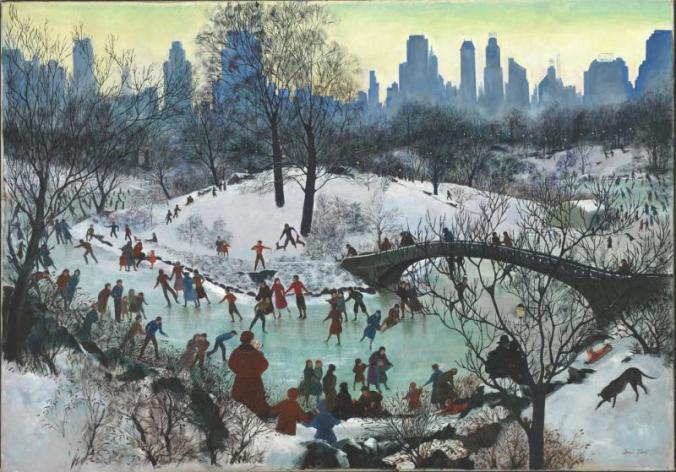
For my final visual review, I decided to look at “Skating in Central Park” by Agnes Tait. This was painted in 1934 as part of the Public Works of Art Project in New York. I love how realistic the painting is and how it shows this happy image of all these people skating and hanging out together, even though it is the Great Depression. This was obviously a very challenging time in American history, as many people lost their jobs and homes, but this image shows a different version of this era.
If one were to view this image as if it was a photograph, it would be considered a wide shot at a slightly high angle. Clearly, the painter was standing on a hill and painted as if she was looking straight forward, with a slight downward angle. There is a low depth of focus in the background since the buildings are blurred together and are not very defined. In general, most of these people are not very defined in the painting either. Even the plants and bare trees are not sharply defined. It makes all the pieces of the image blur together to guide the viewer through the picture, instead of just stopping to look at one part of it.
The flow of the image allows the viewer’s eye to start on the left side of the painting at the tall tree in the foreground. The eyes travel with the snow bank to the bottom of the image – since it gives the perception that this is the closest part of the image to us. The eye follows the snow bank to the right side of the image and across the bridge. The bridge creates a line back towards the middle of the picture that guides the eyes in that direction. Once the bridge ends, the eye travels with the group of skaters in their colorful coats. This, along with the rocks lining the frozen lake, continues to draw the eye back to the left side of the image. The eye then moves upward with the people who are walking up the hill. It continues to follow the dark trees in the background of the picture until we hit the right edge. Finally, the eye moves up and across the back of the image, following the line of the skyscrapers and sky in the background.
The red colors on some of the coats help stand against the white and blue background. This is really the only color that stands out in the painting. Most of the other coats are blue, green or brown and blend in with the cooler tones of the painting. The sky also has cooler tones that hint that it may be late afternoon and the sun is about to begin to set.
While the image still has a shallow field of depth, the viewer can see people in the far background. Some are sledding down a hill on the right side of the image. Others, on the other hand, are talking to one another and walking around.